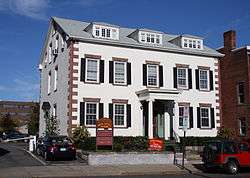John Cook House
The John Cook House is a historic house at 35 Elm Street in New Haven, Connecticut. Built about 1807, it is one of the city's oldest surviving stone buildings, further notable for a parade of locally or statewide prominent residents. The house was listed on the National Register of Historic Places in 1983.[2]
John Cook House | |
 | |
  | |
| Location | 35 Elm St., New Haven, Connecticut |
|---|---|
| Coordinates | 41°18′26″N 72°55′21″W |
| Area | 2.4 acres (0.97 ha) |
| Built | c. 1807[1] |
| Architectural style | Federal |
| NRHP reference No. | 83003576[2] |
| Added to NRHP | November 3, 1983 |
Description and history
The John Cook House is located two blocks east of the New Haven Green in downtown New Haven, on the north side of Elm Street between Orange and State Streets. It is 2-1/2 stories in height, built out of ashlar cut red sandstone that is stuccoed except for the corner quoining blocks, and covered by a gabled roof. The roof face of the roof is pierced by three low hip-roof dormers. Windows are rectangular sash, arranged symmetrically around a center entrance in openings with stone sills and lintels. The entrance is flanked by sidelight windows and sheltered by a projecting portico with Ionic columns.[1]
John Cook, a local tailor and merchant, purchased land for the house in 1805 and 1806, and built it soon afterward. It is one of the oldest stone buildings in New Haven; Timothy Dwight reported in 1800 that the city had none. Cook sold the house in 1814 to Captain James Goodrich, a privateer in the War of 1812. Goodrich had the building's third floor ballroom built; this work is attributed to a locally prominent master builder, David Hoadley. Hoadley was later prominent in business, running the railroad that supplanted the Farmington Canal. In 1858 the house was purchased by Charles Atwater, another prominent businessman and politician who served in the state legislature and was a candidate for Governor of Connecticut. Its next owner, Dr. Charles Lindsley, was a leading figure in the development of public health in the city and state, whose Department of Health he founded. From 1919 to 1967, the house was owned by the local Visiting Nurse Association.[1]
See also
References
- Jack A. Gold and Susan E. Ryan (March 1983). "National Register of Historic Places Inventory-Nomination: John Cook House". National Park Service. and Accompanying 9 photos, exterior and interior, from 1980
- "National Register Information System". National Register of Historic Places. National Park Service. March 13, 2009.